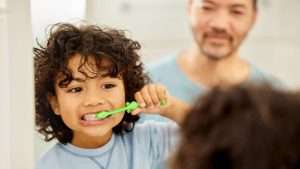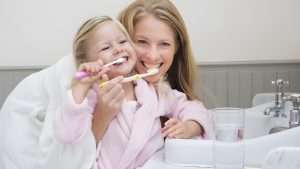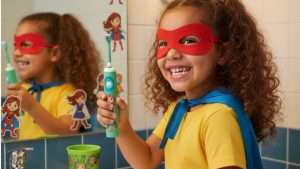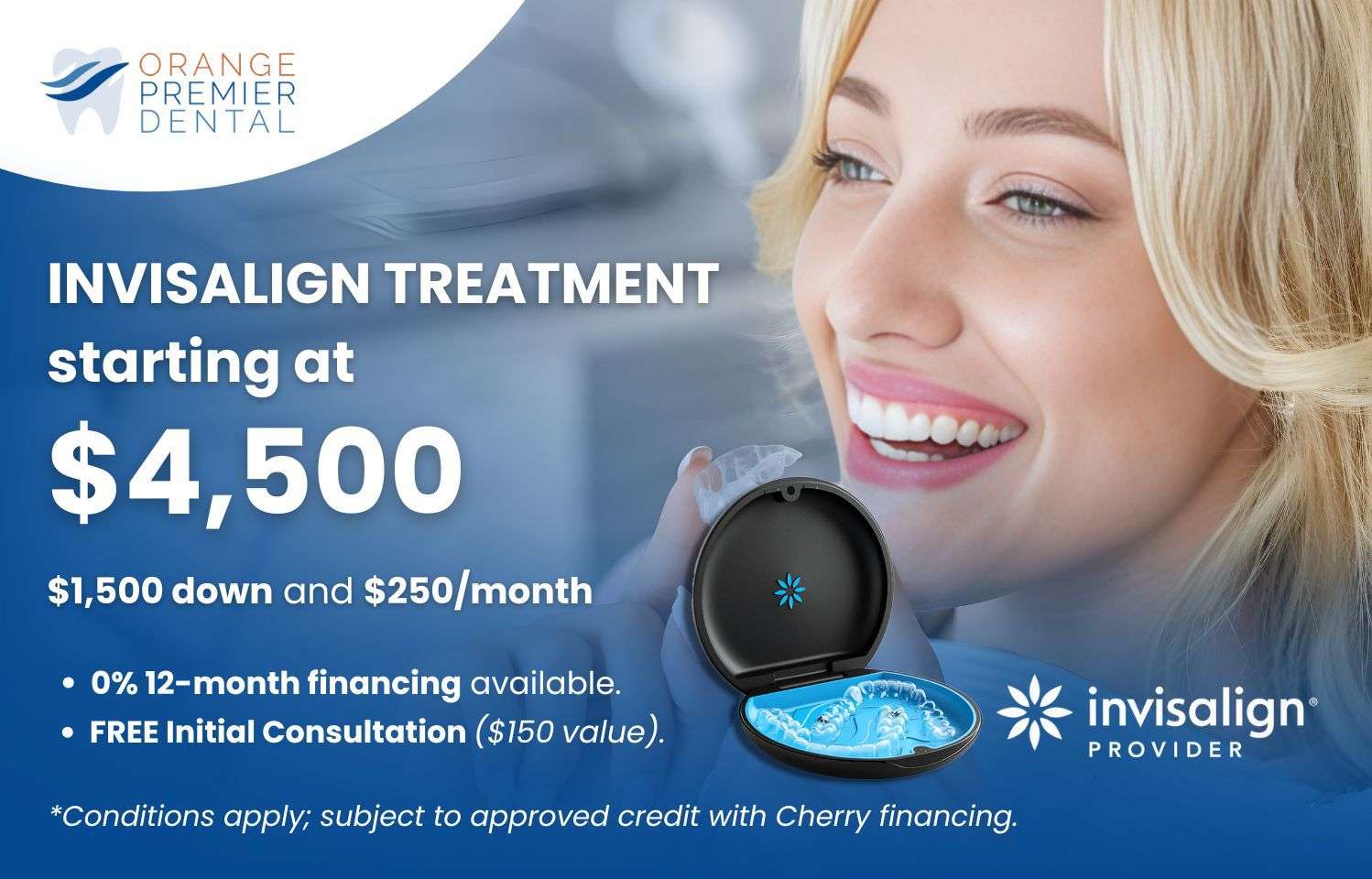
Have you ever tried convincing your toddler to brush their teeth? It definitely feels like a warzone. You are not alone in this situation. They are known for throwing tantrums your way, but teaching kids to brush their teeth is one of the most necessary things you can teach.
Maintaining good hygiene and brushing habits serves as the foundation of lifelong dental care for children. They prevent cavities, strengthen young teeth, and help kids build independence. With a little creativity, patience, and the right approach, you can make brushing a fun, easy, and consistent part of your child’s daily routine. This blog will guide you through the tips and tricks for teaching children proper brushing habits and make your life a lot easier.
Building Healthy Habits Early
Strong yet effective dental hygiene for kids starts way before all their baby teeth develop. Despite the fact that baby teeth eventually fall out, they still play a major role in a child’s speech and eating habits as well as self-confidence. Neglecting early dental health for children can lead to dental problems like cavities, tooth decay, and discomfort, which disrupts their overall health.
Here’s a simple guide to get started:
|
Age Group |
Brushing Frequency | Parental Role |
|
6 months–2 years |
Once daily with a soft brush and water | Brush for your child |
| 2–6 years | Twice daily, using a pea-sized fluoride toothpaste |
Brush with supervision |
| 7+ years | Twice daily, 2 minutes each |
Encourage independence |
Brushing tips for toddlers:
- Start brushing teeth as soon as the first tooth comes in.
- Use a soft-bristle toothbrush that is specially designed for brushing teeth for toddlers.
- Take your child along when you brush your teeth; it will help them learn through example.
- Keep things gentle and playful. A relaxing environment will make them remember this activity and develop a habit.
- Sing them a song, tell a story, and reward them at the end to keep things engaging.
- Stay calm and don’t lose your temper, even if your child resists it at first. Begin with shorter brushing sessions.
By focusing on children’s oral hygiene early in life, you are developing their habits for long-term oral health.
Demonstrating the Right Brushing Technique
Children are imitators. They learn best when they see elders doing things. In order to make dental education for kids effective, show exactly how to help kids brush teeth properly.
Here’s a simple step-by-step guide on how to brush a toddler’s teeth.
- Find an easy and comfortable position by standing behind your toddler and keep things natural.
- Apply a small smear of fluoride toothpaste for kids under 3 years of age and a pea-sized amount for older kids.
- Holding the toothbrush at a 45-degree angle towards the gum line is the best position.
- Use small circular motions and gently brush the inner, outer, and chewing spaces.
- Do not forget to clean your tongue to avoid bad breath gently.
- Brush for at least 2 minutes every day to ensure thorough cleaning.
- After brushing, help them spit out the excess toothpaste and not rinse their mouth. This helps fluoride protect their teeth.
Make Brushing Exciting By Using Fun Toothbrushes for Kids
One of the best tips to encourage children to brush their teeth regularly is to choose the right tools. Fun toothbrushes for kids make the experience exciting rather than boring. Let them pick the toothbrush of their liking. Bright colors, storytelling, and more can help distract kids and guide them towards regularly brushing their teeth.
Try the following ideas to keep your morning playful and engaging for children.
- Character toothbrushes are a great enjoyment for kids. Let them pick their favourite cartoon character or superhero-themed brushes.
- Musical or light-up toothbrushes make brushing interactive and help pass those tantrum-filled 2 minutes real quick.
- Use a brushing buddy. Let them take their stuffed toys along
- Let them pick their favourite flavoured toothpaste. There are plenty of options, such as watermelon and gummies
- Reward charts are another great way to keep kids interested. Use stickers or stars to celebrate each successful morning session and mark progress.
If you’re wondering how to make brushing fun for kids, the secret lies in creativity.

Avoiding Common Mistakes in Dental Care for Children
Even after a lot of effort, sometimes parents can overlook small habits that impact the dental health of their children.
Here are some common mistakes to look out for:
- Gentle cleaning works best. Use light strokes and circular motions instead of harsh scrubbing.
- Supervise and assist children thoroughly at the start. Keep an eye on kids to ensure they are brushing the right way.
- Use the right toothbrush and toothpaste. Don’t go for hard-bristle brushes or strong toothpastes. Also, less is more, so use a pea-sized amount only.
- Make sure your kids brush before bed and in the morning.
- Store toothbrushes in a proper, dry place and a clean area with covers to avoid bacterial growth.
- Flossing alongside brushing is healthy. Start gentle flossing every day,
Turning Brushing Time into Family Time
Kids love to mimic what adults do, so brushing together as a family is one of the best forms of dental education for kids. It shows that brushing isn’t just a “kid chore” but a normal part of everyone’s day.
Here are some fun ways to make it special:
- Brushing games for kids: Have a “toothbrushing dance-off” or play a short two-minute song.
- Storytime brushing: Tell a story about superheroes fighting toothy villains.
- Family challenges: See who can brush for the full two minutes without stopping.
This makes brushing a shared, positive experience, and teaches kids the value of consistency.

When to Visit the Dentist?
At-home care works better when paired with professional checkups. It is recommended for children to visit the dentist by their first birthday or within 6 months of getting their first tooth.
Regular visits allow dentists to:
- Teach kids and parents proper brushing techniques.
- Provide fluoride treatments and cavity checks.
- Spot early signs of misalignment or decay.
These appointments reinforce dental education for kids and make dental visits feel normal and comfortable.
Conclusion
Teaching kids to brush their teeth is more than just about keeping them cavity-free; it’s about teaching responsibility and self-care. With consistent routines, fun toothbrushes for kids, and engaging brushing games for kids, you can make brushing a habit your child actually enjoys.
At Orange Premier Dental, we love helping families build strong, healthy smiles from the very start. Our friendly team provides gentle, expert dental care for children, making every visit comfortable, educational, and fun. Schedule an appointment with us today, and experience compassionate pediatric dental care and guidance.
Frequently Asked Questions
Have you got some questions? We’d be happy to answer.
1. When should kids first go to the dentist?
The first dental visit of your child is to help them feel comfortable about it. The first dental visit is recommended by 12 months of age or within 6 months of the first tooth development.
2. What is dental hygiene for kids?
Dental hygiene for kids can be encouraged with brushing twice a day and maintaining a healthy diet. Regular visits to the dentist and flossing also help.
3. What is the best method of brushing teeth for kids?
Generally, most dentists recommend a circular motion technique for kids. This is not harsh on their gums and is easy to follow.
4. Which is the best toothbrush for kids?
Using a soft-bristle toothbrush is best for kids. This is not harsh on teeth and is a popular choice of parents.

Dr. Shierf Elgamal is the lead dentist at Orange Premier Dental in Orange County. A graduate of Loma Linda University School of Dentistry (2013), he has extensive experience across all areas of general dentistry and is dedicated to providing patients with honest, straightforward care. Over the years, Dr. Elgamal has worked in multiple practices, gaining valuable skills that he now brings to his own clinic.








